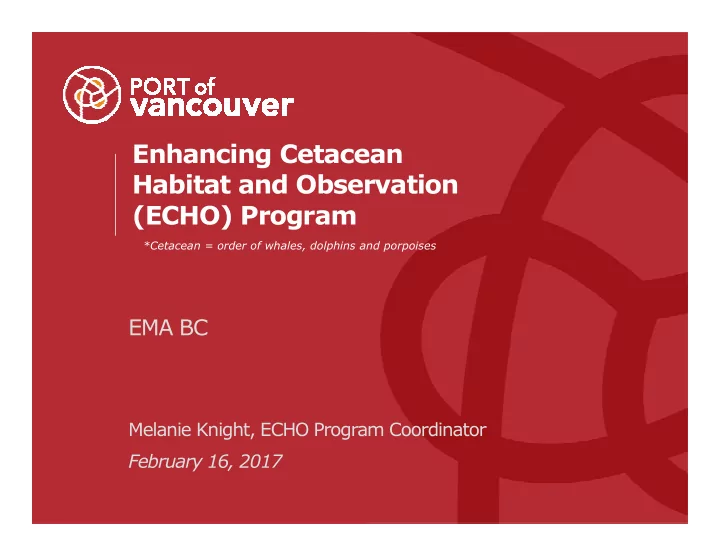

Enhancing Cetacean Habitat and Observation (ECHO) Program *Cetacean = order of whales, dolphins and porpoises EMA BC Melanie Knight, ECHO Program Coordinator February 16, 2017
Overview • Background to marine mammal-vessel interactions • Rationale for and overview of the ECHO Program • ECHO research project highlights • Voluntary measures to reduce impacts • Applications for Environmental Managers
Background to marine mammals in BC
Whales in our backyard Many at-risk marine mammals species throughout the southern coast of British Columbia Erik Christensen NOAA NOAA DFO Fin Sei Harbour Humpback (Threatened) (Endangered) Porpoise (Threatened) (Special Concern) Jim Borrowman HelloBC NOAA NA Blue North Pacific Biggs (transient) Resident killer (Endangered) Right whale killer whale whale (Endangered) (Threatened) (Endangered)
Endangered Southern Killer Whale population trends 1974 – 2016 (NOAA)
Known threats to marine mammals DFO Recovery strategies identify key threat categories and linkages to vessels Acoustic Disturbance Physical Disturbance Environmental Contaminants Availability of prey Photo: BeamReach
Whales, acoustic disturbance and SARA • SRKW are an iconic species and visit seasonally, primarily to feed • Whales use sound to find food, mates, socialize and navigate • Vessel noise can interrupt whales ability to hear returning echolocation clicks – “masking” • Acoustic impacts may lead to “destruction of critical habitat” Sound clip: Northern resident killer whale masking from passing commercial vessel. Credit: Orcalab Whale echolocation
Rationale for & overview of the ECHO Program
ECHO program ECHO: Enhancing Cetacean Habitat and Observation What? A collaboration with marine transportation industries, conservation and environmental groups, First Nations, governments and scientists Why? T o better understand and reduce the cumulative impacts of commercial vessel activities on at-risk whales throughout the southern coast Photo: Joan Lopez of British Columbia *Cetacean: order of whales, dolphins and porpoises
ECHO program context Southern resident killer whale critical habitat in US and • Canada Marine Act mandate Canadian waters overlap international shipping lanes • DFO Recovery Strategies identify threats • Whale and vessel routes overlap • Predicted shipping and population growth
ECHO Program Collaborators Advisory groups Members Federal Government Fisheries and Oceans Advisory Committee Canada, Environment ECHO Program Canada, Transport Canada (bi-annual) (led by VFPA) Marine transportation industries, Advisory Working Group conservation and environmental groups, Aboriginal individuals, (tri-annual meetings) governments and scientists Academia, consultants, Technical Committee(s) government, international (when needed) collaborative organizations
ECHO research project highlights
Alignment with Species at Risk Act Action plans • 18 projects currently underway • Alignment with DFO Action Plans • Project categories align with three main threats • Acoustic disturbance • Physical disturbance • Environmental contaminants
What do different vessels sound like? How does speed impact noise? What is the ambient noise level in the region? How does noise effect whales?
ECHO Underwater Listening Station
ECHO Underwater Listening Station (ULS) ECHO Underwater Listening Station (ULS) Research partnership with Transport Canada, Ocean Networks Canada and JASCO Applied Sciences
ECHO Underwater Listening Station Listening for: • Vessel source levels • Marine mammal detections • Ambient noise data Utility of the data: • Helps vessel owner/operators understand vessel noise • Informs potential incentive • T ests potential vessel noise reduction options Project partners: Transport Canada, Ocean Networks Canada and JASCO Applied Sciences
Vessel Traffic Hotspots Monthly average sound pressure level (July) JASCO Consulting
Southern Resident Killer Whale & Vessel Interaction Hotspots Relative SRKW density May – Sept 94% of SRKW behavioural responses in model area occur between May-Nov SMRU Consulting
Voluntary measures to reduce impacts
Vessel noise reduction options Design options Operational options Hull and propeller design Vessel slow downs • • Classification society Route alterations • • designations Quiet maneuvering training • Efficiency technologies • Quiet or compensation areas •
Design options: VFPA EcoAction incentive program Quiet vessel notations Gold (47% discount) Wake and cavitation reduction technologies Bronze (23% discount) Port of Vancouver award recognizing vessel operators who go above and beyond environmental regulatory requirements.
Operational options: Proposed slow down trial • A voluntary vessel slow down trial is proposed for summer 2017 11kn • Allow real-world data to be gathered • Vessel operator committee convened to advise on trial planning • Economic Impact Assessment Haro Strait
Ongoing educational outreach
Education resources
Applications for Environmental Managers • Underwater noise & whales is a new and emerging issue • Requires a collaborative approach to build trust and momentum
Wrap up Learn more at www.portvancouver.com/echo Or email echo@portvancouver.com Photo: Vancouver Aquarium/NOAA
Recommend
More recommend